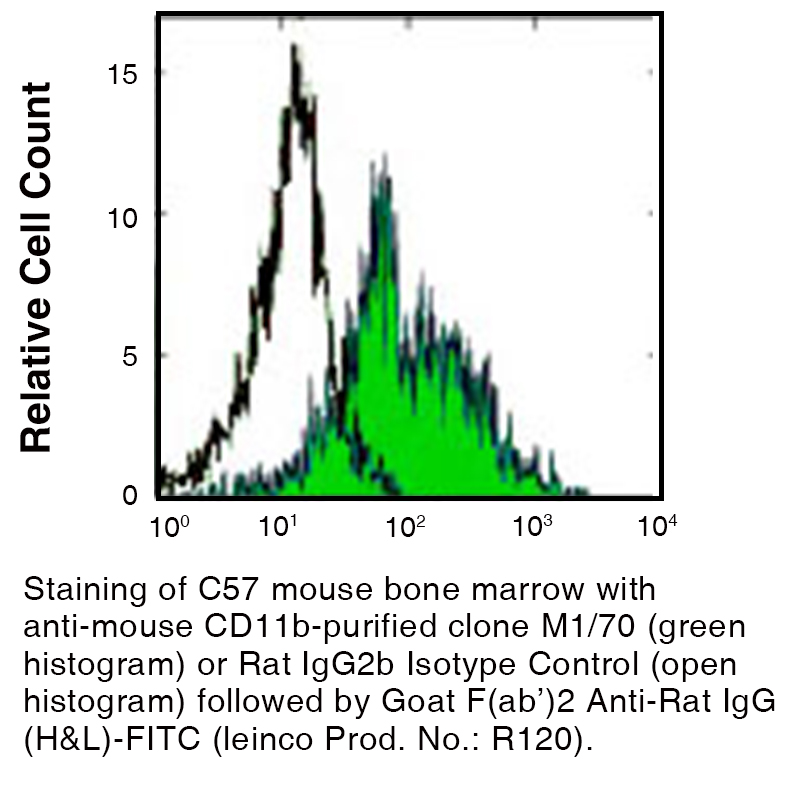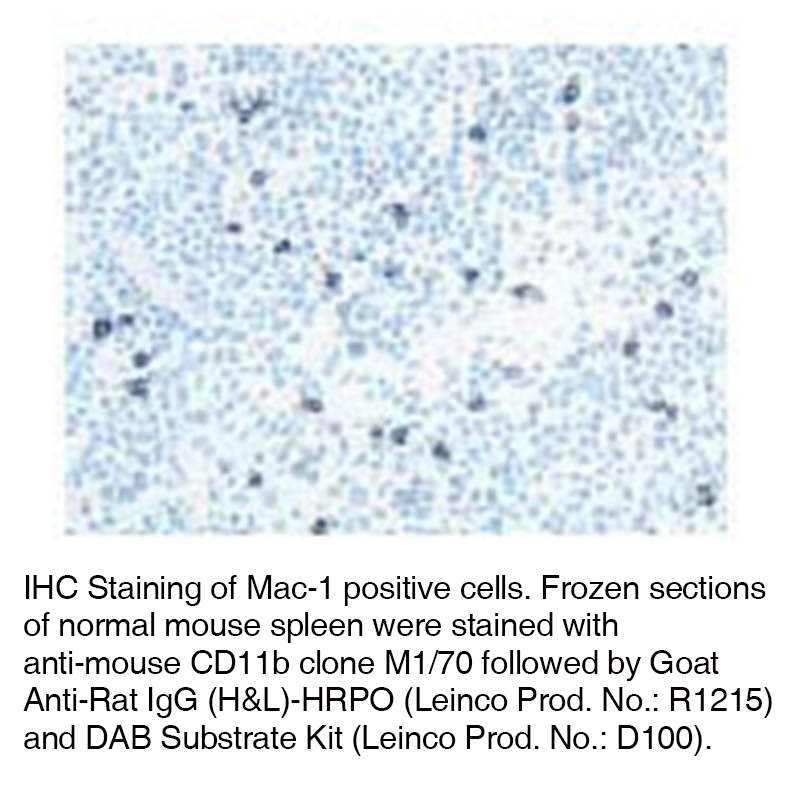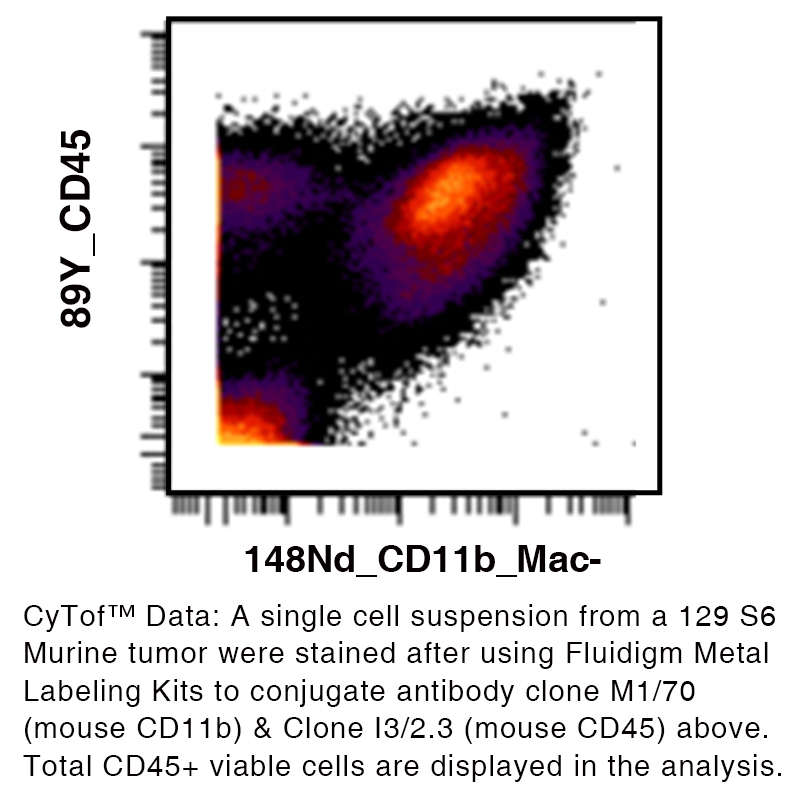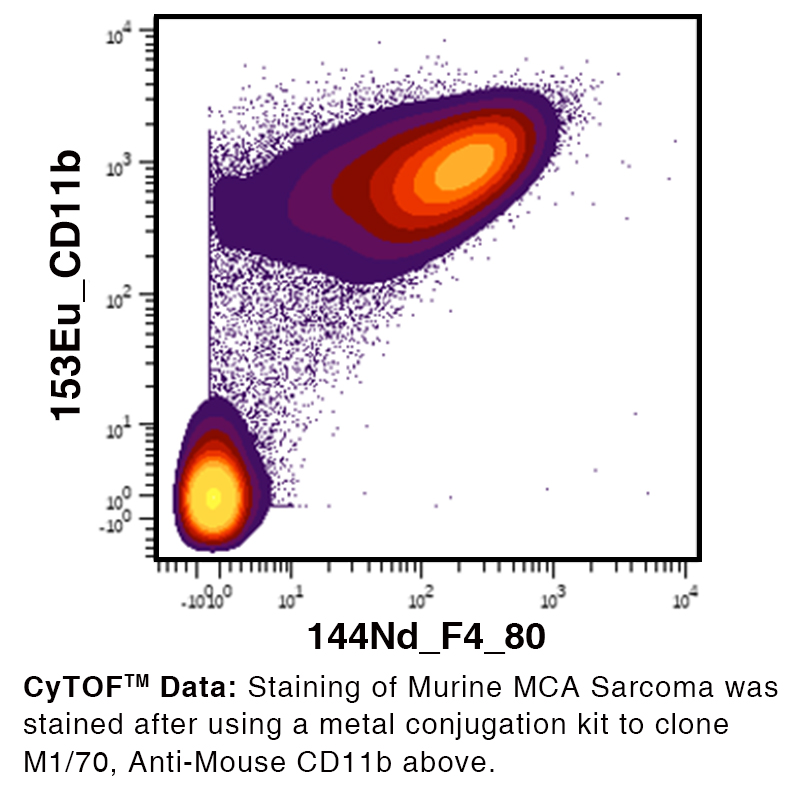Anti-Mouse CD11b – Purified in vivo GOLD™ Functional Grade
Anti-Mouse CD11b – Purified in vivo GOLD™ Functional Grade
Product No.: C377
Clone M1/70 Target CD11b Formats AvailableView All Product Type Monoclonal Antibody Alternate Names Mac-1, Integrin αm chain, C3biR, CR3, Mo1, ITGAM Isotype Rat IgG2b κ Applications CyTOF® , FA , FC , ICC , IHC FF , in vivo , PhenoCycler® |
Data
Antibody DetailsProduct DetailsReactive Species Mouse Host Species Rat Recommended Isotype Controls Recommended Isotype Controls Recommended Dilution Buffer Immunogen B10 mouse spleen cells enriched for T cells Product Concentration ≥ 5.0 mg/ml Endotoxin Level < 1.0 EU/mg as determined by the LAL method Purity ≥95% monomer by analytical SEC ⋅ >95% by SDS Page Formulation This monoclonal antibody is aseptically packaged and formulated in 0.01 M phosphate buffered saline (150 mM NaCl) PBS pH 7.2 - 7.4 with no carrier protein, potassium, calcium or preservatives added. Due to inherent biochemical properties of antibodies, certain products may be prone to precipitation over time. Precipitation may be removed by aseptic centrifugation and/or filtration. Product Preparation Functional grade preclinical antibodies are manufactured in an animal free facility using in vitro cell culture techniques and are purified by a multi-step process including the use of protein A or G to assure extremely low levels of endotoxins, leachable protein A or aggregates. Storage and Handling Functional grade preclinical antibodies may be stored sterile as received at 2-8°C for up to one month. For longer term storage, aseptically aliquot in working volumes without diluting and store at ≤ -70°C. Avoid Repeated Freeze Thaw Cycles. Country of Origin USA Shipping Next Day 2-8°C RRIDAB_2737480 Applications and Recommended Usage? Quality Tested by Leinco FC The suggested concentration for this M1/70 antibody for staining cells in flow cytometry is ≤ 0.25 μg per 106 cells in a volume of 100 μl. Titration of the reagent is recommended for optimal performance for each application. Additional Applications Reported In Literature ? CyTOF® CODEX® ICC IHC (Frozen) Additional Reported Applications For Relevant Conjugates ? B Depletion FC ICC IHC (Frozen) IHC (Paraffin) IP For specific conjugates of this clone, review literature for suggested application details. Each investigator should determine their own optimal working dilution for specific applications. See directions on lot specific datasheets, as information may periodically change. DescriptionDescriptionSpecificity Clone M1/70 recognizes the α subunit (CD11b) of the mouse CD11b/CD18 complex. Background LFA-1α (CD11a) and CD18 are the Integrin alpha-L and beta-2 chains respectively that combine to form LFA-1, a glycoprotein and a member of the Integrin family. Integrin alpha-L/beta-2 is a receptor for ICAM1, ICAM2, ICAM3, ICAM4 and for F11R. LFA-1 participates in the immunological synapses between CD8+ T lymphocytes and antigen-presenting cells. The absence of LFA-1α or ß may induce LAD. The antigen contributes to natural killer cell cytotoxicity, and is involved in various immune phenomena such as leukocyte-endothelial cell interaction, cytotoxic T-cell mediated killing, and antibody dependent killing by granulocytes and monocytes. The CD11b/CD18 antigen is a heterodimeric surface glycoprotein on leukocytes and belongs to the ß2 integrin family. CD11b functions as a receptor for C3bi complement, clotting factor X, fibrinogen and ICAM-1. CD11c forms an α/ß heterodimeric glycoprotein (CD11c/CD18 complex) which belongs to the ß2 integrin family. The complex binds fibrinogen and reportedly serves as a receptor for iC3b and ICAM-1. During inflammatory responses, it mediates cell to cell interaction and is important in both monocyte adhesion and chemotaxis. Antigen Distribution CD11b is expressed on human peripheral blood lymphocytes, NK lymphocytes, monocytes, granulocytes, a subset of T-cells and macrophages. Ligand/Receptor ICAM-1 (CD54), ICAM-2 (CD102), ICAM-4 (CD242), iC3b, fibrinogen Function Adhesion, chemotaxis PubMed NCBI Gene Bank ID UniProt.org Research Area Cell Adhesion . Cell Biology . Costimulatory Molecules . Immunology . Innate Immunity . Neuroscience . Neuroscience Cell Markers Leinco Antibody AdvisorPowered by AI: AI is experimental and still learning how to provide the best assistance. It may occasionally generate incorrect or incomplete responses. Please do not rely solely on its recommendations when making purchasing decisions or designing experiments. Clone M1/70 is commonly used in in vivo mouse studies to target CD11b-expressing cells, which include macrophages, monocytes, neutrophils, and some dendritic cells and NK cells. This antibody has several well-established functional applications in live animal research. Depletion StudiesOne of the primary in vivo applications is cell depletion, where M1/70 is used to selectively remove CD11b-expressing myeloid cells from the system. This approach allows researchers to study the functional role of these immune cell populations by observing the effects of their absence. Blocking and NeutralizationM1/70 serves as a blocking antibody to inhibit CD11b function in vivo. The antibody can block iC3b binding to its receptor, thereby interfering with complement-mediated interactions and other CD11b-dependent cellular functions. This neutralization capacity makes it valuable for understanding the role of CD11b in various immune responses and inflammatory processes. Imaging ApplicationsRecent applications include using radiolabeled M1/70 for PET-CT imaging to visualize bone marrow cell density changes in response to therapy. Specifically, 64Cu-labeled M1/70 has been employed to noninvasively assess functional bone marrow and monitor CD11b+ cell populations following chemotherapy treatments like Abraxane. Detection and PhenotypingBeyond functional manipulation, M1/70 is widely used as a marker antibody to detect and quantify CD11b expression on various myeloid cell populations in vivo, helping researchers track macrophages, granulocytes, neutrophils, and NK cells during experimental treatments. For in vivo studies requiring high purity and low endotoxin levels, Ultra-LEAF™ purified formulations (with endotoxin < 0.01 EU/µg, azide-free, and 0.2 µm filtered) are specifically recommended to minimize unwanted immune activation. Commonly used antibodies or proteins that are cited alongside M1/70 (anti-CD11b) in the literature for immunophenotyping or functional studies of myeloid and immune cell populations include:
These markers are frequently combined with M1/70 in multicolor flow cytometry panels, immunohistochemistry, and cell depletion or enrichment protocols to define, characterize, and manipulate mouse myeloid and related immune cell subsets.
These combinations allow researchers to resolve macrophage, monocyte, dendritic cell, and granulocyte populations with greater precision in mouse tissues, both at steady-state and in disease or experimental conditions. Clone M1/70 is a widely used monoclonal antibody targeting CD11b (integrin alphaM), with key findings in the scientific literature highlighting its central role in immunology, tumor biology, and inflammation research. Key findings include:
Summary Table: Main Applications and Key Insights
In summary, clone M1/70 is indispensable for dissecting myeloid cell biology, integrin function, inflammatory processes, and the tumor microenvironment. Its blocking ability allows not just for cell marking, but also for probing the functional consequences of CD11b inhibition in experimental systems. References & Citations1.) Springer, T.A., et al. (1978) Eur. J. Immunol. 8:539 2.) Springer, T.A., et al. (1982) Immunol. Rev. 68:171 3.) Ding, A., et al. (1987) J Exp Med. 165:733 4.) Vignali, D. A. et al. (1990) J. Immunol. 144:4030 5.) Kantor, A. et al. (1992) Proc. Natl. Acad. Sci. U.S.A. 89:3320 6.) Gubin, M. et al. (2018) Cell. 175(4):1014–1030 Journal Link Technical ProtocolsCertificate of Analysis |
Related Products
Prod No. | Description |
|---|---|
S211 | |
R1364 | |
I-1034 | |
C247 | |
F1175 | |
R1214 | |
S571 |
Formats Available
Prod No. | Description |
|---|---|
C1906 | |
C341 | |
C227 | |
C228 | |
C230 | |
C229 | |
C1628 | |
C1629 | |
C1630 | |
C1632 | |
C515 | |
C377 | |
C677 |
 Products are for research use only. Not for use in diagnostic or therapeutic procedures.
Products are for research use only. Not for use in diagnostic or therapeutic procedures.






